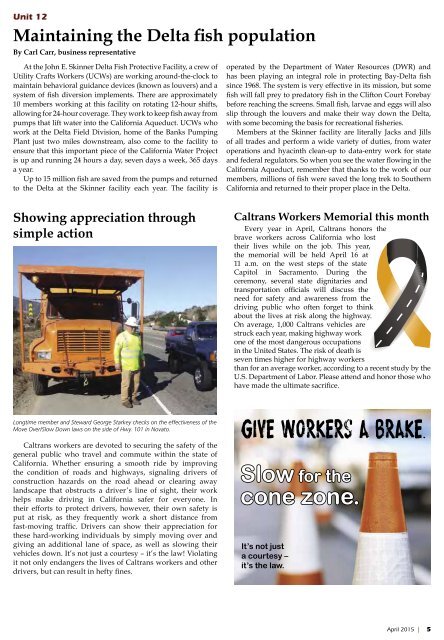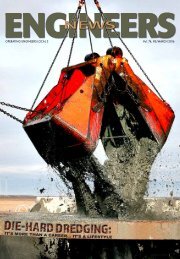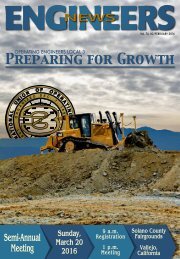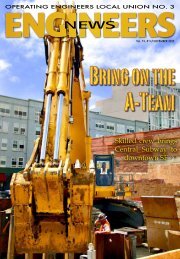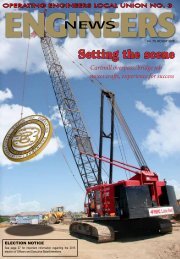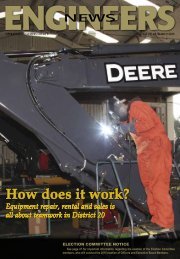Engineers News - April 2015
April 2015: San Francisco Proud - Work on high-profile Transbay Transit Center continues
April 2015: San Francisco Proud - Work on high-profile Transbay Transit Center continues
You also want an ePaper? Increase the reach of your titles
YUMPU automatically turns print PDFs into web optimized ePapers that Google loves.
Unit 12<br />
Maintaining the Delta fish population<br />
By Carl Carr, business representative<br />
At the John E. Skinner Delta Fish Protective Facility, a crew of<br />
Utility Crafts Workers (UCWs) are working around-the-clock to<br />
maintain behavioral guidance devices (known as louvers) and a<br />
system of fish diversion implements. There are approximately<br />
10 members working at this facility on rotating 12-hour shifts,<br />
allowing for 24-hour coverage. They work to keep fish away from<br />
pumps that lift water into the California Aqueduct. UCWs who<br />
work at the Delta Field Division, home of the Banks Pumping<br />
Plant just two miles downstream, also come to the facility to<br />
ensure that this important piece of the California Water Project<br />
is up and running 24 hours a day, seven days a week, 365 days<br />
a year.<br />
Up to 15 million fish are saved from the pumps and returned<br />
to the Delta at the Skinner facility each year. The facility is<br />
operated by the Department of Water Resources (DWR) and<br />
has been playing an integral role in protecting Bay-Delta fish<br />
since 1968. The system is very effective in its mission, but some<br />
fish will fall prey to predatory fish in the Clifton Court Forebay<br />
before reaching the screens. Small fish, larvae and eggs will also<br />
slip through the louvers and make their way down the Delta,<br />
with some becoming the basis for recreational fisheries.<br />
Members at the Skinner facility are literally Jacks and Jills<br />
of all trades and perform a wide variety of duties, from water<br />
operations and hyacinth clean-up to data-entry work for state<br />
and federal regulators. So when you see the water flowing in the<br />
California Aqueduct, remember that thanks to the work of our<br />
members, millions of fish were saved the long trek to Southern<br />
California and returned to their proper place in the Delta.<br />
Showing appreciation through<br />
simple action<br />
Caltrans Workers Memorial this month<br />
Every year in <strong>April</strong>, Caltrans honors the<br />
brave workers across California who lost<br />
their lives while on the job. This year,<br />
the memorial will be held <strong>April</strong> 16 at<br />
11 a.m. on the west steps of the state<br />
Capitol in Sacramento. During the<br />
ceremony, several state dignitaries and<br />
transportation officials will discuss the<br />
need for safety and awareness from the<br />
driving public who often forget to think<br />
about the lives at risk along the highway.<br />
On average, 1,000 Caltrans vehicles are<br />
struck each year, making highway work<br />
one of the most dangerous occupations<br />
in the United States. The risk of death is<br />
seven times higher for highway workers<br />
than for an average worker, according to a recent study by the<br />
U.S. Department of Labor. Please attend and honor those who<br />
have made the ultimate sacrifice.<br />
Longtime member and Steward George Starkey checks on the effectiveness of the<br />
Move Over/Slow Down laws on the side of Hwy. 101 in Novato.<br />
Caltrans workers are devoted to securing the safety of the<br />
general public who travel and commute within the state of<br />
California. Whether ensuring a smooth ride by improving<br />
the condition of roads and highways, signaling drivers of<br />
construction hazards on the road ahead or clearing away<br />
landscape that obstructs a driver’s line of sight, their work<br />
helps make driving in California safer for everyone. In<br />
their efforts to protect drivers, however, their own safety is<br />
put at risk, as they frequently work a short distance from<br />
fast-moving traffic. Drivers can show their appreciation for<br />
these hard-working individuals by simply moving over and<br />
giving an additional lane of space, as well as slowing their<br />
vehicles down. It’s not just a courtesy – it’s the law! Violating<br />
it not only endangers the lives of Caltrans workers and other<br />
drivers, but can result in hefty fines.<br />
It’s not just<br />
a courtesy –<br />
it’s the law.<br />
<strong>April</strong> <strong>2015</strong> |<br />
5


